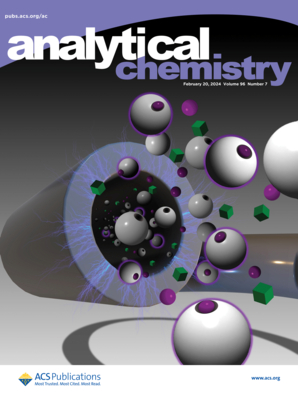Improvements in Glycoproteomics through Architecture Changes to the Orbitrap Tribrid MS Platform
IF 6.7
1区 化学
Q1 CHEMISTRY, ANALYTICAL
引用次数: 0
Abstract
Hardware changes introduced on the Orbitrap Ascend Tribrid MS include dual ion routing multipoles (IRMs) that enable parallelized accumulation, dissociation, and Orbitrap mass analysis of three separate ion populations. The balance between these instrument functions is especially important in glycoproteomics, where complexities of glycopeptide fragmentation necessitate large precursor ion populations and long ion accumulation times for quality MS/MS spectra. To compound matters further, dissociation methods like electron transfer dissociation (ETD) that benefit glycopeptide characterization come with overhead times that slow down scan acquisition. Here we explored how the Orbitrap Ascend’s dual IRM architecture can improve glycopeptide analysis, with a focus on O-glycopeptide characterization using ETD with supplemental collisional activation (EThcD). We found that parallelization of ion accumulation and EThcD fragmentation increased scan acquisition speed without sacrificing spectral quality, subsequently increasing the number of O-glycopeptides identified relative to analyses on the Orbitrap Eclipse (i.e., the previous generation Tribrid MS). Additionally, we systematically evaluated ion–ion reaction times and supplemental activation energies used for EThcD to understand how best to utilize acquisition time. We observed that shorter-than-expected ion–ion reaction times minimized scan overhead time without sacrificing c/z•-fragment ion generation and that higher supplemental collision energies can generate combinations of glycan-retaining and glycan-neutral-loss peptide backbone fragments that benefit O-glycopeptide identification. We also saw improvements in N-glycopeptide analysis using collision-based dissociation, especially with methods using faster scan speeds. Overall, these data show how architectural changes to the Tribrid MS platform benefit glycoproteomic experiments by parallelizing scan functions to minimize overhead time and improve sensitivity.

通过对Orbitrap tribridms平台结构的改变改进糖蛋白组学
Orbitrap Ascend Tribrid质谱仪的硬件变化包括双离子路由多极(IRMs),可以对三种不同的离子群进行并行积累、解离和Orbitrap质量分析。这些仪器功能之间的平衡在糖蛋白组学中尤为重要,糖肽断裂的复杂性需要大量的前体离子群和长时间的离子积累时间才能获得高质量的MS/MS光谱。更复杂的是,电子转移解离(ETD)等解离方法有利于糖肽的表征,但其开销时间会减慢扫描采集速度。在这里,我们探讨了Orbitrap Ascend的双IRM架构如何改善糖肽分析,重点是使用ETD和补充碰撞激活(EThcD)来表征o糖肽。我们发现离子积累和EThcD碎片的并行化在不牺牲光谱质量的情况下提高了扫描采集速度,随后相对于在Orbitrap Eclipse(即上一代Tribrid MS)上的分析,增加了鉴定的o -糖肽的数量。此外,我们系统地评估了离子离子反应时间和用于EThcD的补充活化能,以了解如何最好地利用采集时间。我们观察到,离子反应时间比预期的短,在不牺牲c/z•片段离子生成的情况下,最大程度地减少了扫描开销,并且较高的补充碰撞能量可以生成保留聚糖和聚糖中性损失肽主链片段的组合,有利于o糖肽的鉴定。我们还看到了使用基于碰撞的解离法进行n-糖肽分析的改进,特别是使用更快扫描速度的方法。总的来说,这些数据表明,Tribrid MS平台的架构变化如何通过并行扫描函数来减少开销时间并提高灵敏度,从而使糖蛋白组学实验受益。
本文章由计算机程序翻译,如有差异,请以英文原文为准。
求助全文
约1分钟内获得全文
求助全文
来源期刊

Analytical Chemistry
化学-分析化学
CiteScore
12.10
自引率
12.20%
发文量
1949
审稿时长
1.4 months
期刊介绍:
Analytical Chemistry, a peer-reviewed research journal, focuses on disseminating new and original knowledge across all branches of analytical chemistry. Fundamental articles may explore general principles of chemical measurement science and need not directly address existing or potential analytical methodology. They can be entirely theoretical or report experimental results. Contributions may cover various phases of analytical operations, including sampling, bioanalysis, electrochemistry, mass spectrometry, microscale and nanoscale systems, environmental analysis, separations, spectroscopy, chemical reactions and selectivity, instrumentation, imaging, surface analysis, and data processing. Papers discussing known analytical methods should present a significant, original application of the method, a notable improvement, or results on an important analyte.
 求助内容:
求助内容: 应助结果提醒方式:
应助结果提醒方式:


